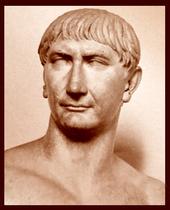Trajan, a life long soldier of considerable reputation became the catalyst that would secure Nerva's reign and provide for a smooth transition of power between the Flavians and the so-called '5 Good Emperors'. He maintained an air of familiarity with his men and came to be endeared by them. However, his authority was unquestionable and his familiarity with provincial administration thanks to his father's and his own long terms of service abroad, provided a firm foundation for imperial governing.
He re-affirmed the vow by Nerva that no Senator would be harmed and applied the Augustan principals of the principate. Trajan was considerate and mindful to Republican tradition making sure that the position of emperor appeared again like that of a first citizen among peers rather than a despot that ruled at his own whims. He ruled with an outward lack of political ambition and it endeared him to both the masses and the aristocracy. Coupled with his abilities as a general and conqueror, he would come to be loved as a model of Roman virtue and dignity.
The new emperor was greeted by the people of Rome with great enthusiasm, which he justified by governing well and without the bloodiness that had marked Domitian's reign. He freed many people who had been unjustly imprisoned by Domitian and returned a great deal of private property that Domitian had confiscated; a process begun by Nerva before his death.
The imperial court was minimal in comparison to previous 'administrations' and Trajan preferred a low key approach to government. There was no royal court no imperial pomp and no intrigue throughout his reign. He would rely upon provincial governors to make decisions on their own merits and defer to the emperor only it matters of extreme importance.
Thanks to Pliny the Younger, the provincial governor whose correspondence with Trajan is largely extant, a vivid portrait of Trajan's style can be seen. In effect, his rule was much like that of a general using subordinate officers in a military sense.
Like Nerva, Trajan continued the popular measures that punished the delators (informers) for their part in creating administrative disorder and he reduced the power of the Praetorians and reformed the court system.
Thoughout Trajan's reign there was an ever-increasing programme of public works. The roads network in Italy was renovated, sections which passed through wetlands being paved or placed on embankments and many bridges were built.
Also provisions for the poor were made, especially for children. Special imperial funds (alimenta) were created for their upkeep. (This system would still be in use 200 years later!). In the short time that he stayed in Rome, Trajan prepared the Roman world for 60 years of steady and effective leadership.
His popularity was such that the Roman Senate eventually bestowed upon Trajan the honorific of optimus, meaning "the best".
Trajan's reign too was notable for inclusion of women in imperial public life. Having no children of his own and a considerably small primary family, the influence of his wife and sister is perhaps unrivalled in Roman history. Unlike such previous imperial women as Livia (wife of Augustus), Messalina and Agrippina (wives of Claudius with the latter being the mother of Nero), the women in Trajan's life were considered positive influences and were honored for their service to the empire rather than vilified in the historical record. Pompeia Plotina, Trajan's wife was as simple and benevolent as her husband. Later, Plotina and Marciana, his sister were both honored with the title of Augusta in AD 105.
As an emperor, Trajan's legacy proved to be one of the most enduring in the history of the Roman Empire, and in reputation second only to that of Augustus. Every new emperor after Trajan was honoured by the Senate with the prayer felicior Augusto, melior Traiano, meaning "may he be luckier than Augustus and better than Trajan". Contrary to many lauded rulers in history, this reputation survived nearly undiminished for over nineteen centuries.
The Roman Empire under Trajan
Theologians, such as Thomas Aquinas, discussed Trajan as an example of a virtuous pagan. In the Divine Comedy, Dante, following this legend, sees the spirit of Trajan in the Heaven of Jupiter with other historical and mythological persons noted for their justice.
